Learn how to make an ultra-conditioning bar of all-natural Winter Spice Pine Soap to help moisturize your dry winter skin! With an amazing sweet-spicy evergreen scent it will be your new favorite seasonal bar of soap.
Before You Begin
If you are new to making soap, I suggest reading my post on how to make soap for beginners first.
I also highly recommend Jan Berry’s Natural Soapmaking eBook and eCourse!
They are perfect for beginners and have step by step instructions for making your own natural soaps, with recipes too. It’s how I learned how to make soap!
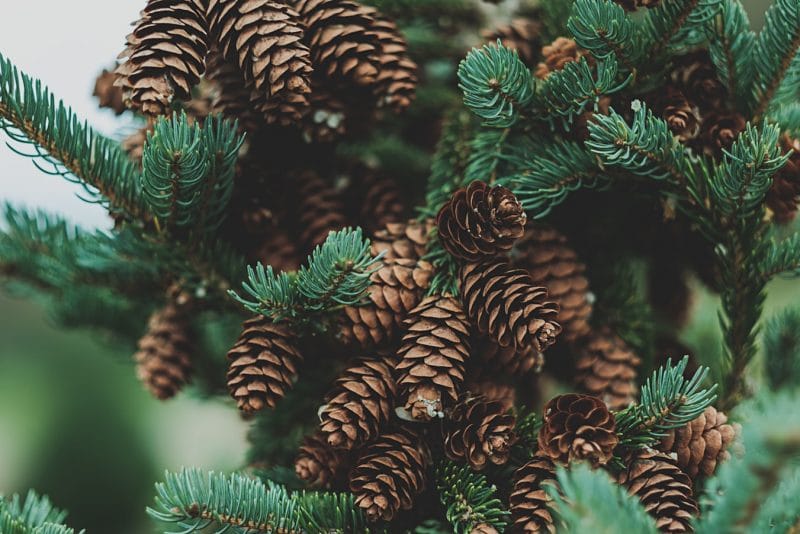
Norway Spruce
Pine Soap Ingredients
{This post is sponsored by Mountain Rose Herbs}
- 13 ounces Pine Needle Infused Olive Oil (see instructions below)
- 10 ounces Coconut Oil
- 7 ounces Avocado Oil
- 2 ounces Castor Oil
- 12.16 ounces Pine Needle Tea, frozen into ice cubes
- 4.54 ounces sodium hydroxide (lye)
- 1 teaspoon chlorella powder
- .25 ounce sweet orange essential oil
- .25 ounce pine essential oil
- .25 ounce cinnamon leaf essential oil
This homemade pine soap recipe is for a vegan, all-natural, cold processed soap. It makes about 10 bars depending on your soap mold.
Because this is a palm-free vegan soap recipe, it is on the softer side so I recommend an 8-week cure time. But the final bar will be just as cleansing without sacrificing any of the moisturizing properties.
Olive oil and avocado oil are ultra-conditioning while the coconut oil makes a bar that will get you clean as can be. The castor oil is added to help give the lather a bit of a boost.
You can make a few substitutions on the essential oils if you need to. Fir needle essential oil smells amazing and works well in the place of the pine essential oil. The cinnamon leaf essential oil is simply a less expensive alternative to cinnamon essential oil, but smells identical.
One thing I love about this amazing essential oil blend is that it doesn’t fade like other essential oils can do in cold processed soap. In fact, I came across a bar with this blend two years after I made it and it still smelled just as delightful as it did on day one!
For the green colorant, I used chlorella powder. I wish I could use a herbal colorant but in my experience, they fade to brown fairly quickly.
Chlorella powder or liquid chlorophyll are my favorite natural green colorants for soap I’ve used so far. If you’d like an all-green bar of pine soap, simply add 1 heaping tablespoon after trace and use the immersion blender to mix it in well.
How to Make Pine Soap
Because the bulk of the oils used in this pine soap recipe are already liquid, it doesn’t have that passive waiting time while the oils cool down like many other soap recipes.
And because the water portion (the pine needle tea) is frozen into ice cubes first, the lye mixture doesn’t heat up above 100 degrees F. This means all of the ingredients are ready to go, right in that comfortable 90-degree range and you can move on with your day sooner.
Begin making Winter Spice Pine Soap by creating a couple of herbal infusions. Which means it’s time to do some winter foraging!
I tend to find excuses not to go out into the cold, but I never regret it once I’m outdoors so this soap is a good reason to suit up for an excursion into the woods.
While you’re out foraging for pine needles grab a little extra for making your next batch of Pine Needle Cough Syrup or some of these other amazing Conifer Needle Recipes.
Pine Needle Infused Herbal Oil
While you can use any conifer needle to create the herbal infusions in soap, I chose White Pine.
The primary species on our land are White Pine and Norway Spruce (with a dozen or so Red Pine in the mix). I find the White Pine needles to be easier to harvest and make the a fragrant herbal infusion.
I used extra virgin olive oil because that’s what I had on hand, but bear in mind that the color of extra virgin olive oil along with the avocado oil will make the “white” portion of this soap off-color, a little towards the yellow side.
You can do a cool infusion or a warm infusion depending on how busy you are (and how quickly you need the soap to be ready.)
I packed a quart jar full of pine needles and covered it with the oil. Just be sure to infuse a few ounces more than the approximate 13 ounces required for this recipe because you’ll lose some along the way as it coats the needles and the sides of the jar.
Learn more from our articles about making an herbal infused oil or conifer infused oil.

White Pine
Pine Needle Tea
Preparing a pine needle tea is just as straightforward as it sounds. You can use any edible conifer needle you have available to you (avoid Yew as it is toxic). Once again, I used white pine.
In this case, I didn’t bother measuring the liquid. I simply packed the quart jar and covered it with boiling water. Allow the needles to steep in the water until it has cooled to room temperature and then strain the needles out.
I pretty much freeze all of the water portion into ice cubes when soap making. Whether it’s plain water, herbal tea, or milk, there are little to no fumes after the lye is mixed in. There is also no rush to make soap whenever the tea is ready if something happens to come up, and there is no wait time while the liquid/lye mixture cools back down.
Make the Pine Soap
Once your infusions have been prepared, it’s time to make pine soap!
You will want to get the coconut oil melting on a double boiler. Since there are so few solid oils in this recipe I just added the coconut oil to a mason jar and set that in the water-filled saucepan to boil.
Meanwhile, measure out the remaining ingredients. I begin with the lye/pine needle tea mixture in case it needs to cool down before mixing it into the oils.
Add the lye to the ice cubes in a glass bowl and slowly mix them with a spatula. Makes sure you’re wearing safety glasses and rubber gloves just in case it splashes. Once the lye has completely dissolved, set the bowl aside.
Measure out the essential oils and colorants and set them aside.
In a separate bowl measure out the liquid oils. It’s a good idea to measure each one individually and then add them together. When you’re mixing liquid oils , there’s no taking them back out if you accidentally pour in too much!
Once the coconut oil has melted, stir it into the liquid oils. Then pour the liquid oils into the lye mixture and stir them until combined. Then it’s time to break out the immersion blender.
Using the stick blender, mix the pine soap until it reaches a light trace. Because there are few solid oils, this may take a little longer than normal. I made sure to verify trace using a thermometer. To do this, all you have to do is take a base temperature of the mixture after stirring it all together.
After a few minutes using the stick blender, check the temperature again. Once you’ve seen it rise 3 degrees or so you know that the chemical reaction has happened even if it’s difficult to see trace.
Add in the essential oil blend and give it another good go-around with the immersion blender.
If you’ll be swirling the soap, remove about 10 ounces of the batter to another bowl. Use the immersion blender to mix in the chlorella powder.
Pour about ⅘ of the white batter into a loaf mold. Spoon a little over half of the green batter over the white batter. (I drop it from high so the momentum will cause it to sink deeper into the white batter.)
Take a chopstick or even the thermometer probe and swirl the soap a little. Insert it at about a 45-degree angle and simply draw circles moving towards the other side of the mold as you swirl.
Spread a thin layer of the white batter over the top then follow it with the remainder of the green batter, spreading it carefully so as not to mix the 2 layers.
Curing and Decorating the Soap
With my tallow-based recipes, the soap is usually ready to remove from the mold after a day or two. This soap took a little longer to harden because of the liquid oils. For the same reason, it will also take longer to cure.
Technically, you can use it after curing for 4 weeks, but if you can resist the temptation, it will last a lot longer if you let it cure for at least 8 weeks.
This pine soap would look beautiful with a sprinkling of spruce needles along the top, maybe a few juniper berries to increase the wintry piney scent.
Dried hawthorn berries or even rainbow peppercorns would also be a lovely addition!
Be sure to share your love of soap making with your friends and family because this Winter Spice Pine Soap makes the perfect homemade gift!
More Natural Soap Recipes
Here are some more soap recipes for you to make now that you know the basics:
Winter Spice Pine Soap
Equipment
Ingredients
- 13 ounces olive oil infused with pine needles
- 10 ounces refined coconut oil
- 7 ounces avocado oil
- 2 ounces castor oil
- 12.16 ounces pine needle tea frozen into ice cubes
- 4.54 ounces sodium hydroxide (lye)
- 1 teaspoon chlorella powder
- .25 ounces sweet orange essential oil
- .25 ounces cinnamon leaf essential oil
- .25 ounces pine needle essential oil
Instructions
Pine Needle Herbal Oil
- Pack a quart jar full of pine needles and cover it with at least 15 ounces olive oil.
- Set the jar in a sunny window for a few weeks to infuse OR place it in a saucepan of water and place it on warmer burner or in a slow cooker filled part way with water on the warm setting.
- After a few hours to overnight, strain the pine needles from the olive oil.
Pine Needle Tea
- Bring about 3 cups of water to a boil.
- Add the pine needles and remove from heat.
- After the tea has cooled to room temperature, strain out the pine needles.
- Freeze the tea into ice cubes, if desired.
Pine Soap
- Measure out the coconut oil into a quart mason jar and place it in a small saucepan of water.
- Bring the water to a boil until the coconut oil melts then remove the jar from the heat.
- Meanwhile, weigh the avocado oil, castor oil, and pine needle infused olive oil and pour them into a bowl.
- Weigh out the sodium hydroxide (lye) into a small glass bowl or glass measuring cup. (Be sure to wear safety glasses and rubber gloves while working with lye!)
- Weigh out the pine needle tea ice cubes into it's own large glass bowl.
- Slowly sprinkle the sodium hydroxide (lye) over the ice cubes while stirring with a silicone spatula until the lye has fully dissolved. Set aside.
- Pour the melted coconut oil into the other liquid oils and give them a little stir.
- Weigh out the essential oils into a small container (not plastic.) Set aside.
- Measure out the chlorella. Set aside.
- Pour the oil mixture into the lye mixture and stir them together with the silicond spatula for a minute.
- Take the temperature of the mixture.
- Using an immersion blender mix the oils and lye together until they thicken and leave a raised, "trace" across the top of the mixture. If the temperature has risen about 3+ degrees, you can know for sure you've traced. You want this soap batter to be a little on the runnier side.
- Stir in the essential oil blend and mix it in well with the immersion blender for another minute.
- Pour about 10 ounces of the batter into another bowl. (I used the one the oils were in.)
- Mix in the chlorella powder.
- Pour about 4/5 of the white soap batter into your mold.
- Using drop large spoonfuls of green batter from high above the mold into the white batter.
- Use a chopstick or thermometer probe to swirl the soap a little. Insert it at about a 45-degree angle and simply draw circles moving towards the other side of the mold as you swirl.
- Spread a thin layer of white batter over the top, followed by the remainder of the green batter.
- After it sets up for about 15-20 minutes depending on the thickness of the batter, embellish the top, if desired.
- Cover with plastic wrap and allow it to sit until the soap has hardened enough to remove it from the mold.
- Cut the soap into bars and allow them to sit for 4-8 weeks to cure.



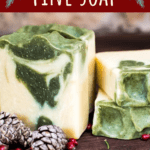


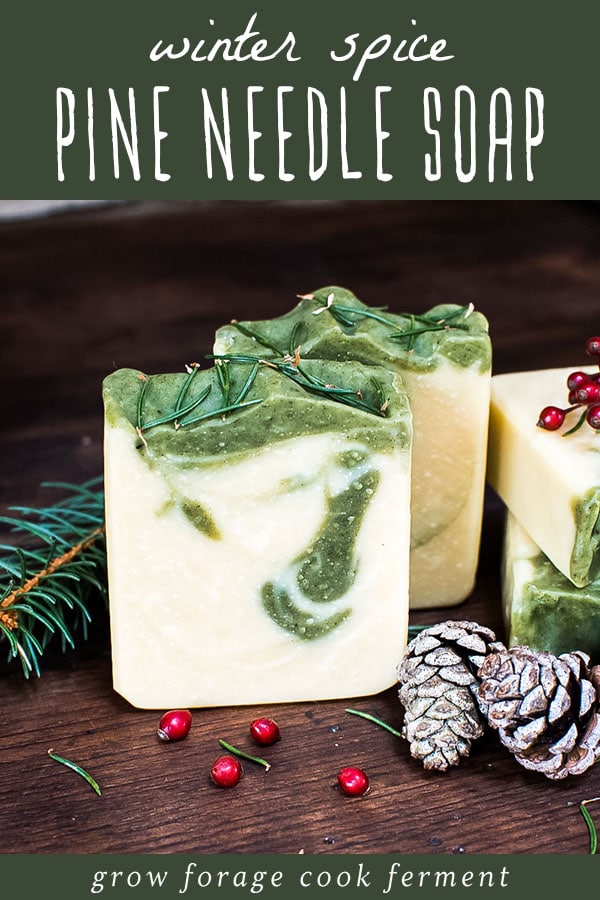
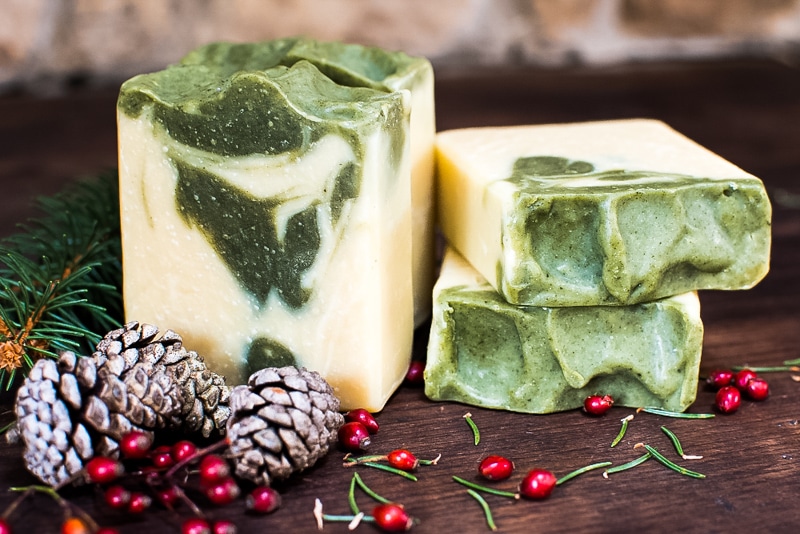
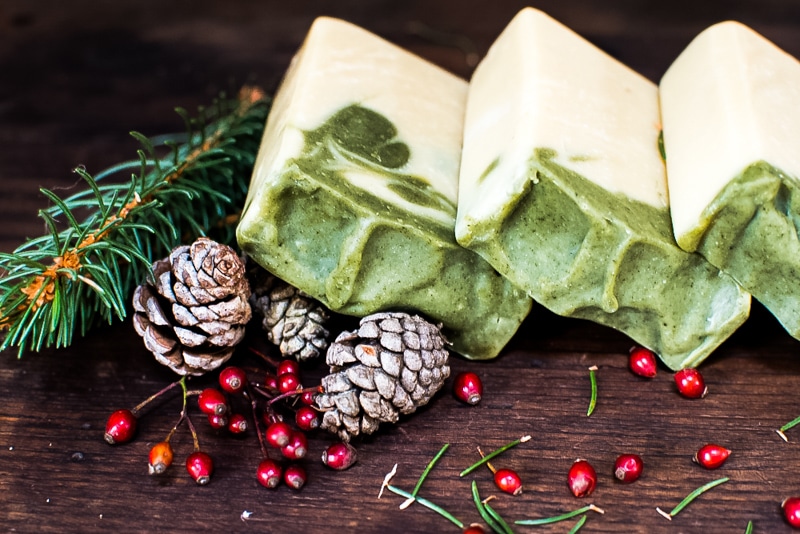
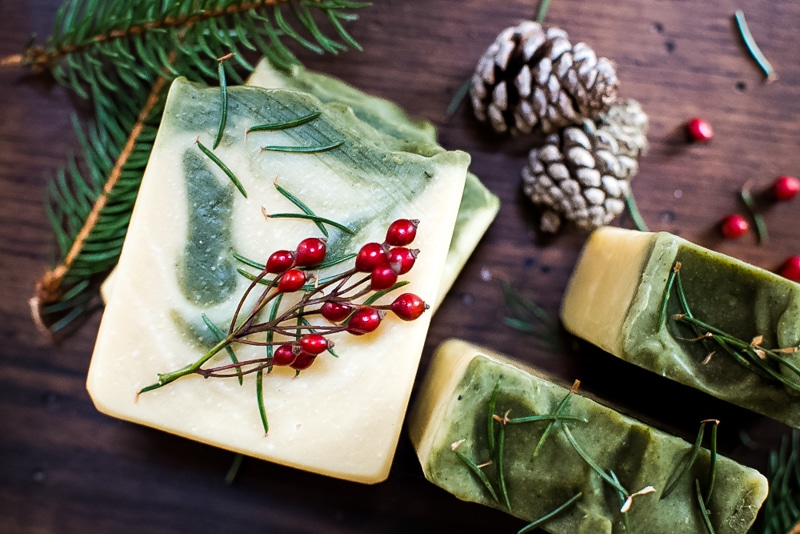
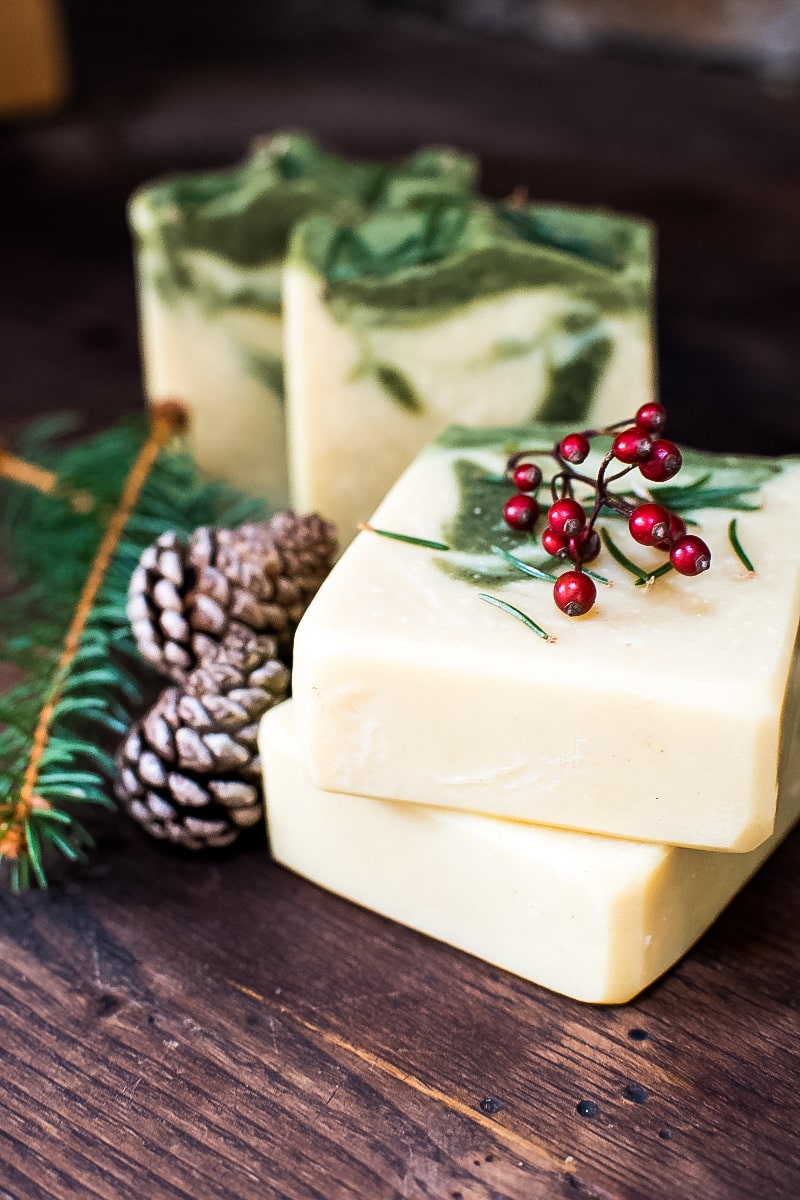


Will the pine needle olive oil infusion smell better than pine essential oil? I purchased some of that recently and it just smells like Pine-Sol 🤢
It likely won’t smell as strong.
Really nice web page, and great, easy to follow info! Can’t wait to try it, thanks!
Thank you!
This makes a great hard bar, nice lathering bubbles, and just the right amount of moisturizing! I smell mostly cinnamon when the bars are done curing. The colors are beautiful also. They fade a bit over time, but that doesn’t detract from their attractiveness, besides they don’t have chemical dyes.
Can this recipe be doubled straight across, or does CP soap not allow for that?
Thanks for posting!
Hi there. I’m so happy you enjoyed this recipe! Yes, you can definitely double the recipe for your next batch. Enjoy!
This produced a lovely, hard bar of soap with a soft lather. The scent is lovely—primarily cinnamon and orange (the pine is a little harder to detect in the finished product) and thus maybe little less masculine than I had imagined (I was planning to make this as Christmas gifts for male family members). But, my husband does like the scent as it reminds him of the holidays. The swirl is gorgeous (my first time swirling soap) and the use of foraged pine makes it particularly special. Thank you for another lovely tutorial!
Woohoo! I’m so glad you liked the recipe!
Hello, do you recommend cutting the needles off of the branch or can you do the tea and infused oil with the needles still attached to the wood?
I remove the needles from their stem before packing them in a jar to get the most out of the extraction. If I included the stems too, they’d take up more space than I’d prefer.
I am loving this soap, though every time I make it, the pine needle tea and lye turn an amber color, so it’s never white. Also, the trace accelerates at a crazy pace when I add the oils. Are there any tips? I combine the oils and lye mixture when they are both 100ºF.
Hi Gregg, I would suggest freezing the pine needle tea and using ice cubes to soap at a cooler temperature. It should solve both of the issues. The only other thing I could think of is trying the opposite in regards to the pine needles- if you’re using dehydrated needles, try fresh. If fresh, try dehydrated. While the standard is to make oil infusions with dry plant material, there’s not a lot of water content in fresh pine needles so it should be fine. Wondering if dried pine needles might be “staining” the oil?
Do you ever use titanium dioxide in your soaps to keep the color preserved? Just curious. I’ve thought about using it, but am kind of apprehensive. I look forward to making this soap. It will be gifts for Winter Solstice this year.
Hi Colleen. Should one use fresh pine needles or dried ones? Thanks
Hi, Nina. You’ll want to use dried pine needles for both the pine needle tea and infused oil.
Dear Coleen, I love your recipes. especially this one and the dandelion soap.
What size does your soap bar have? what mold are you using for it?
The proportions of pine soap and dandelion soap are so good and express the elegance of the soap bar even more.
thank you for sharing the info with me:)
best
Matylda
I can’t wait to try this recipe! I will be going out foraging today. Thanks for sharing.